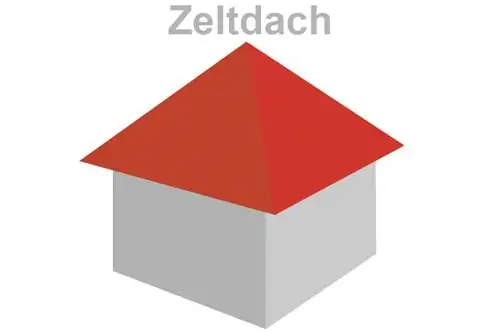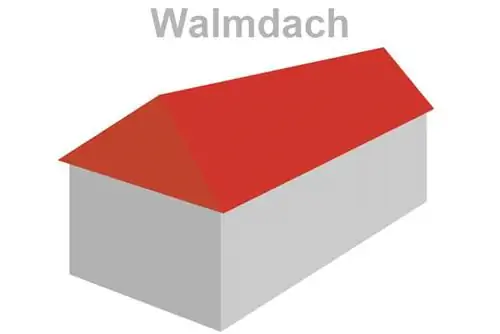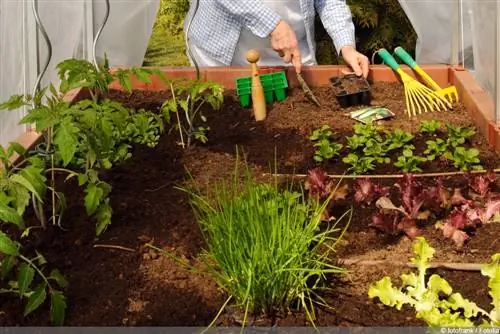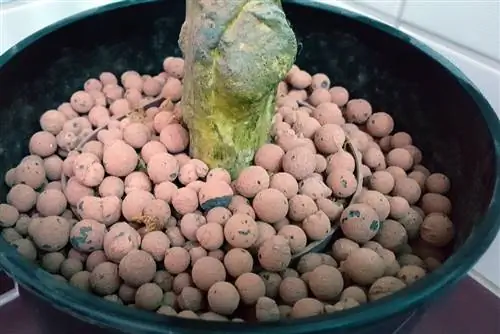- Author admin [email protected].
- Public 2023-12-17 03:39.
- Last modified 2025-01-24 12:45.
In the garden, the water trough is a useful and decorative element. The design can be chosen to match the garden design, but it should be able to withstand the weather elements. The practical water container makes work in the garden easier as there is always water for irrigation nearby. The materials to choose from include concrete, natural stone and plastic, which have various advantages and disadvantages.
Water trough
The water trough is available from specialist retailers in various versions that can be adapted to the size of the garden and the intended use. There is also a wide selection of materials and shapes. As a rule, water troughs are made of either concrete, natural stone or plastic. In addition, wood can also be made completely waterproof to serve as a water container. However, this material is far more susceptible to the effects of the weather, which significantly shortens its lifespan. Deep sub-zero temperatures and prolonged rain can quickly cause damage to water troughs. Since the trough is exposed to the sun and changing weather conditions all year round, the material used should be able to withstand them over the long term. Based on the differences in the choice of materials and the size, the purchase prices also vary accordingly.
- Water troughs are used to collect rainwater
- Can be strategically placed
- Provide the gardener with additional space for irrigation water
- Collected water can be useful for cleaning garden supplies
- Can be designed as a mini pond or birdbath
- Can serve as a basin for the garden fountain
- Water trough represents additional work in the garden
- For hygienic reasons, troughs must be cleaned regularly
Concrete
Concrete is a modern building material that is extremely versatile and offers the gardener unlimited design options. It can also be used for many purposes in the garden. Concrete water troughs can be made to size as required and according to the space available. Aesthetically speaking, this building material conveys puritanical design aspects. Thanks to its structural physics attributes, this material is extremely robust. Due to its variable properties, this building material can be tailored specifically to the required loads. A concrete water trough has a much more elegant appearance than a plastic container. In addition, it can be decorated as desired, for example with shells or pieces of roots on the edge. However, concrete proves to be problematic in terms of sustainability and environmental friendliness because its production requires large amounts of energy. Therefore, this building material does not make sense in terms of the greenhouse effect.
Advantages:
- Almost indestructible building material with a long service life
- Versatile for the garden area
- Extremely waterproof, easy to clean
- Even more resistant to dirt, acid and water thanks to surface sealing
- Both frost hardy and insensitive to sun
- Important weight ensures sufficient safety
- Concrete water trough is fixed and stable
- Features extremely high compressive strength
- Exudes modern aesthetics, conveys an authentic urban look
- Fits well in pure gardens, for example in Japanese style
- Special effects possible through polishing, grinding and waxing
- Great variety of shapes and sizes
Disadvantages:
- Production of concrete involves significant CO2 emissions
- High weight makes transport and moving difficult
- Gray color can seem monotonous and boring
- Significantly higher purchase price compared to plastic
- With old age there is a risk of cracks and deformation
- Disposal of concrete troughs is very difficult
Plastic
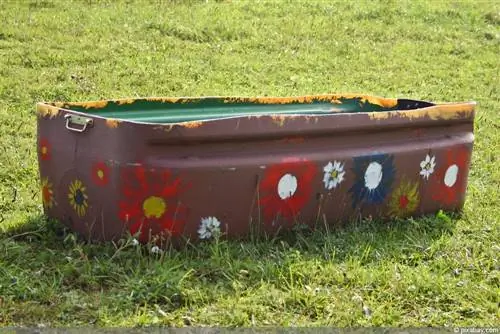
Plastic is a powerful building material that can be processed into many products. The material is well suited for a water trough that should find its place in the garden. The extremely light material has only a minimal density compared to concrete and natural stone. In addition, plastic does not conduct and provides sufficient insulation against electricity and heat. In addition, plastic troughs are resistant to water and retain this property for a long time. However, this material becomes more and more sensitive as it ages, especially due to the influence of the weather. Extremely strong sunlight and very low temperatures make plastic troughs increasingly porous and can cause damage. Added to this is the weight and volume of the water, which means cracks and holes can form in the material over time. However, due to the low purchase price, an exchange is possible without any problems.
Advantages
- Very good waterproofing
- Plastic troughs have a smooth surface
- Easy to clean and does not oxidize
- Low weight, ideal for variable use
- Easy transport and quick repositioning possible
- Sufficiently frost-hardy material
- Inexpensive alternative to concrete and natural stone
- Wide range of shapes and sizes
- Plastic troughs can be dressed up in a variety of ways
- Natural stone slabs and bricks are ideal for this
Disadvantages
- Plastic troughs are not very scratch-resistant
- Have limited resistance to weather
- Deform due to extreme temperature values
- Severe frost and blazing midday sun damage the material
- Most plastics are highly flammable
- Organic solvents attack plastic containers
- Difficult to dispose of as plastics rot extremely slowly
Natural stone
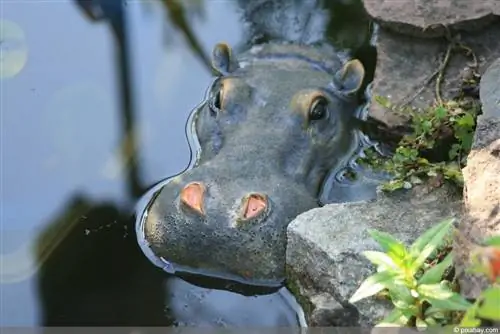
Another material for a water trough can be natural stone. There are various natural stones with a different look to choose from. These are ideal for garden design and underline the natural ambience of the garden. Natural stones last almost forever and usually require little maintenance. That's why this material is very suitable for making water troughs. It is possible to provide the water trough made of natural stone with a hole in the ground, which is then connected to a sewer pipe. A fountain can be made this way. When using it as a water trough, the gardener must check whether the surface is sufficiently stable. Otherwise, the trough may sink later due to its heavy weight. Another advantage of natural stone over other building materials is that it requires significantly less energy to extract and process it.
Advantages
- Very multi-faceted and durable material
- You can choose from bas alt, granite, marble, sandstone, slate, limestone, etc.
- Excellent Waterproofness
- Weight ensures good stability
- Weather-resistant and frost-proof material
- Often made by hand
- Natural surfaces with a beautiful look
- Periodic basic cleaning of the troughs is recommended
- Natural stone is unproblematic when disposed of
- Contains no harmful substances
Disadvantages
- Extremely high weight
- Transportation and relocation are difficult to accomplish
- Natural stones often have unevenness
- Differences in colors and inclusions are common
- High purchase price
- Not suitable for every surface
Tip:
The drainage hole in the floor can also be equipped with a standpipe. In this way, the water level in the trough can be regulated as needed using the length of the standpipe.



